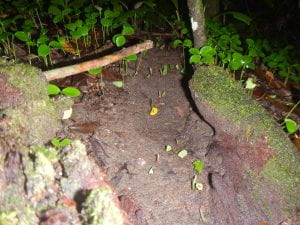Today was our first (and hardest) full day of hiking in the rainforest! We started with an early-morning birding session fueled by coffee and awe. We heard melodious blackbirds, and saw black vultures, turkey vultures, ocellated turkeys, plumbeous kites, TWO toucans, and a collared aricari.
After a hearty breakfast, we drafted an experimental design to characterize the habitat use of predators and prey in the Chiquibul, and we suited up for a long hike to set up some camera traps.
Dr. Solomon gave me an aspirator to suck up ants into a little viewing chamber for easier identification. I didn’t get to (or need to) use it today on our hike, but it is very cool, in theory, to be like an anteater slurping up ants in the rainforest. I did see a new ant species today: the army ant (Eciton sp.)! At first, I thought it was another leafcutter (Atta cephalotes) trail, because they were moving in a straight line rather than the carpet-like swarms that are associated with the army ant species that I know of (E. burchellii), but their conspicuous reddish-color and large soldier class still identifies them as army ants.
I also saw the same type of Ponerine/Hypoponerine ant that I saw at Caracol yesterday, and this time I got some really good close up pictures, so hopefully I can consult the ant guide book and get a positive ID.
We also saw an absolutely humungous leafcutter ant nest deep in the rainforest on our hike (we set up a camera trap there, so we have an excuse to go back in a couple days). The mound was probably four feet tall and several meters in radius with dozens of entrance tunnels and ventilation shafts! Dr. Solomon said that the entire biomass of the colony was about equivalent to that of a cow, and that they probably consume about the same amount of vegetation per day.

